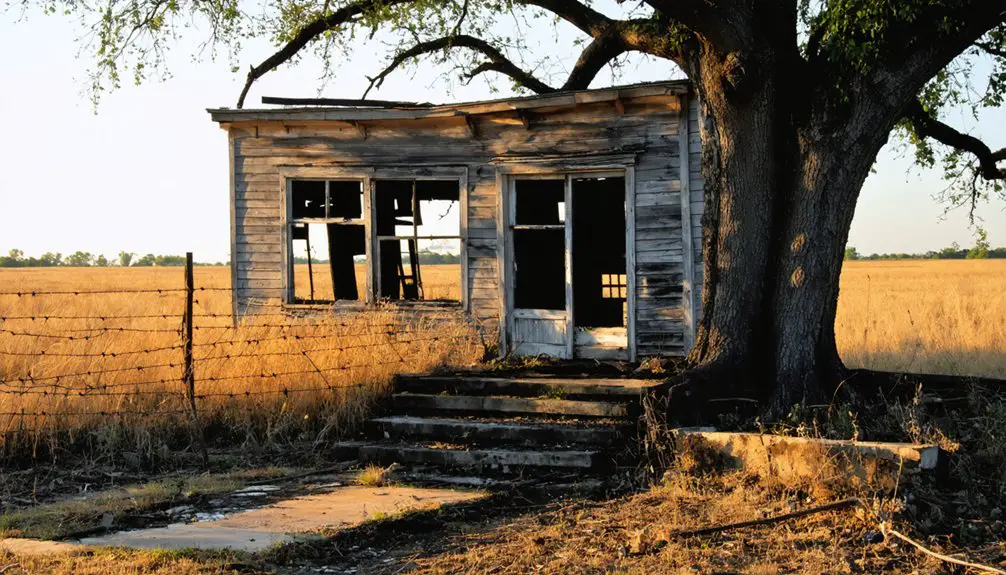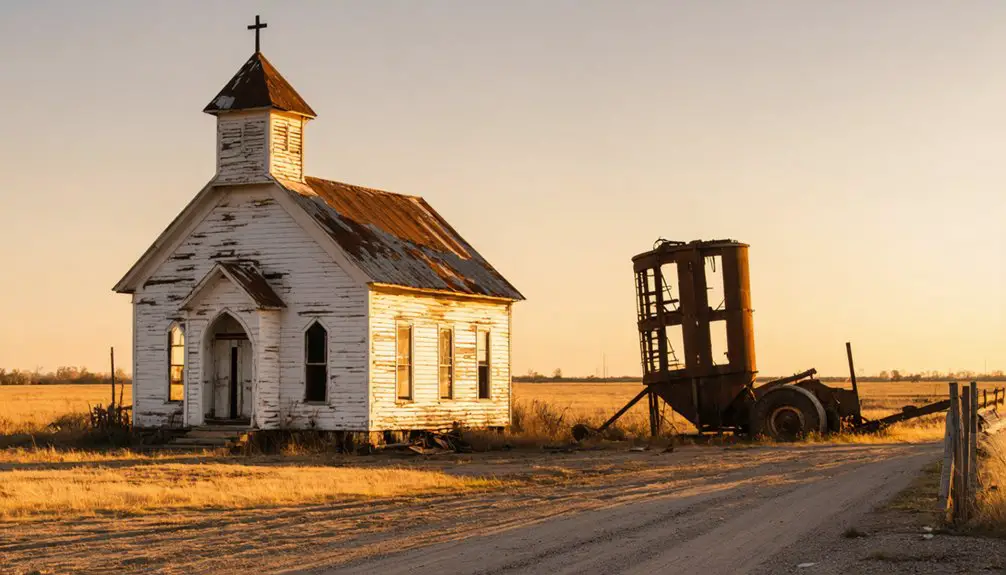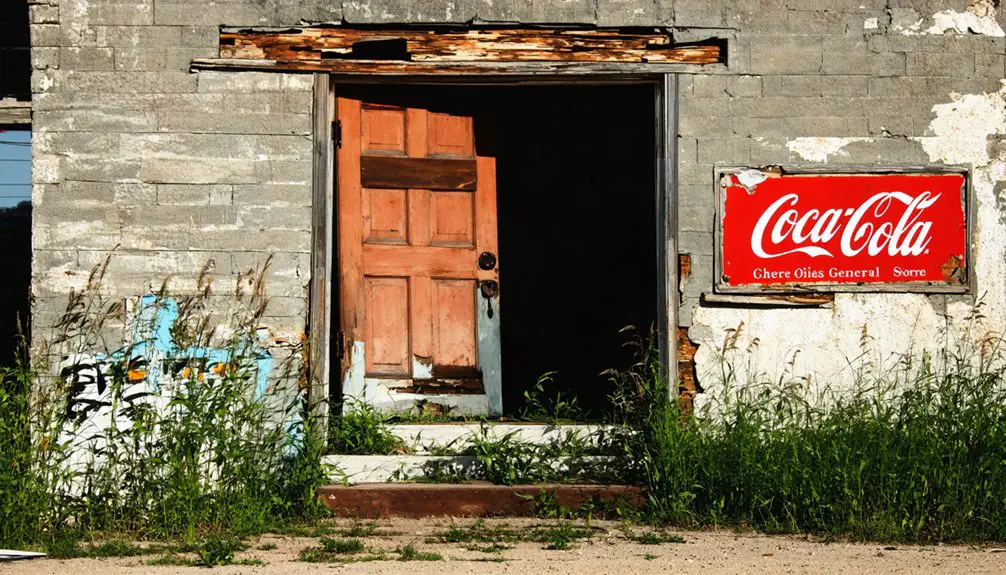You’ll find Chahta Tamaha, a ghost town in Bryan County, Oklahoma, as the former capital of the Choctaw Nation from 1863 to 1883. The settlement grew around Armstrong Academy, established in 1845 for Choctaw boys’ education. During the Civil War, the academy served as both a Confederate hospital and the seat of tribal government. After the capital’s relocation to Tuskahoma in 1883, Chahta Tamaha declined, with Armstrong Academy’s destruction by fire in 1921 marking its final chapter. The site’s rich history reveals deeper insights into Native American governance and resilience.
Key Takeaways
- Chahta Tamaha became a ghost town after the Choctaw Nation’s capital moved to Tuskahoma in 1883, causing rapid economic decline.
- The settlement’s final downfall occurred in 1921 when Armstrong Academy burned down and the federal government refused reconstruction.
- Originally established around Armstrong Academy in 1845, Chahta Tamaha served as the Choctaw Nation’s capital from 1863 to 1883.
- The abandoned site’s legacy remains through Armstrong Academy Cemetery and its listing on the National Register of Historic Places.
- Located along U.S. Highway 70, the ghost town’s remains showcase the historical transition of Native American governance in Oklahoma.
Origins and Early Development of Chahta Tamaha
The establishment of Armstrong Academy proved vital to the community’s early development, as it attracted both Choctaw families and missionaries to the area.
The school’s presence helped sustain the initial settlement, creating a foundation for what would later become the Choctaw Nation’s capital.
The surrounding natural resources, including the Kiamichi River and forests, supported the growing community’s basic needs.
In 1863, the community gained prominence when the Choctaw capitol moved from Doaksville to Chahta Tamaha.
The Academy served as the primary government facility until 1883 when the Council House sessions resumed at the school.
Armstrong Academy’s Role in Shaping the Settlement
Armstrong Academy’s educational mission transformed the Pushmataha District settlement into a center of learning for Choctaw boys before its operations were disrupted by the Civil War.
You’ll find that the Academy’s strategic location and facilities made it an invaluable Confederate hospital camp, where approximately 250 soldiers were eventually laid to rest.
The institution’s prominence led to its selection as the Choctaw Nation’s capital in 1863, when it became known as Chahta Tamaha, serving as the seat of government until 1883.
The site’s historical significance is preserved along U.S. Highway 70, making it accessible to those interested in exploring this chapter of Oklahoma’s past.
Educational Legacy Before War
Founded in 1845 as a boarding school for Choctaw boys, Armstrong Academy quickly emerged as a pivotal educational institution that would shape the cultural and intellectual landscape of the Choctaw Nation.
The academy’s educational practices balanced academic rigor with practical skills. You’d find students dividing their day between traditional subjects like reading, writing, and mathematics, while also spending several hours working the academy’s farmland.
Student experiences were shaped by a diverse teaching staff, including notable educators like Mrs. Potts and Elizabeth W. Earle. Under the supervision of Protestant missionaries and Choctaw trustees, the academy maintained an average enrollment of 65 boys. The school was forced to close its doors when the Civil War broke out, disrupting education for its students.
The institution’s $3,900 annual budget, primarily funded by the Choctaw Nation’s treasury, demonstrated the tribe’s commitment to educational self-determination.
Strategic Confederate Hub
When civil war erupted across America in 1861, peaceful classrooms at Armstrong Academy transformed into bustling Confederate command centers. You’ll find this strategic location became crucial for military logistics, serving as both a hospital for wounded soldiers and headquarters for Confederate operations in Indian Territory.
At Armstrong Academy, you’d have witnessed unprecedented tribal alliances forming as Cherokee, Chickasaw, Creek, Choctaw, Seminole, and Caddo delegates gathered to coordinate with Confederate forces.
The site’s significance grew when it became the Choctaw capital of Chahta Tamaha in 1863. The Confederacy promised these tribes statehood and honored neglected treaties, cementing their loyalty.
The academy’s position helped secure supply lines and deterred Union advances, while the surrounding settlement flourished with increased trade and commercial activity supporting the war effort. During this time, the Confederate forces captured the J. R. Williams riverboat, marking a significant victory in controlling river traffic.
Capital’s Temporary Home
Through a constitutional amendment in 1863, the Choctaw Nation officially designated Armstrong Academy as its permanent seat of government, transforming the bustling educational center into Chahta Tamaha (“Choctaw Town”).
You’ll find this educational transformation marked a pivotal shift, as the academy’s facilities began hosting the Choctaw National Council meetings, integrating both academic and governmental functions under one roof.
The governmental integration brought notable Choctaw leaders like Peter P. Pitchlynn, Allen Wright, and Jackson McCurtain to the settlement, establishing it as the nation’s political nucleus.
While the academy’s original educational mission paused, the site flourished as an administrative hub until 1883.
That year, when the capital relocated to Tuskahoma, Chahta Tamaha’s prominence began to fade, though the academy would later reopen specifically for orphaned Choctaw boys.
The Civil War Years and Political Prominence
During the Civil War, you’ll find Armstrong Academy transformed from a school into an essential Confederate hospital serving wounded soldiers throughout Indian Territory.
At the same facility in 1863, the Choctaw Council established Chahta Tamaha as their capital and hosted significant meetings with the United Nations of Indian Territory delegates to coordinate Confederate strategy.
You’ll discover that these wartime operations positioned Chahta Tamaha as a center of both medical care and political leadership, where Principal Chief Peter P. Pitchlynn and other Choctaw leaders orchestrated their nation’s Confederate alliance.
Confederate Hospital Operations
As the Civil War engulfed the region, Armstrong Academy in Chahta Tamaha transformed from an educational institution into an essential Confederate hospital serving wounded soldiers from battles across the Choctaw Nation territory.
You’d find hospital conditions at Armstrong Academy that were typical of the era – primitive medical practices, severe supply shortages, and high infection risks.
After its conversion to a hospital, the national academy for boys ceased educational operations until after the war ended.
Like other Confederate facilities, the hospital relied on improvised wards where surgeons performed amputations and basic procedures under unsanitary conditions.
The medical staff included Confederate doctors and local laborers, both Native American and enslaved, who provided nursing support. The survival of Armstrong Academy’s hospital operations depended heavily on enslaved workers’ labor, mirroring the situation at other Confederate medical facilities.
Despite the harsh realities of Civil War medicine, Armstrong Academy’s hospital played a vital role in Confederate military operations throughout the territory until the war’s conclusion.
Choctaw Government War Planning
When the Civil War erupted in 1861, the Choctaw Nation‘s government made a decisive choice to ally with the Confederate States of America, fundamentally shaping their wartime trajectory.
The war strategy involved deploying troops to defend key installations like Fort Washita while coordinating with Confederate envoy Albert Pike to establish multi-tribal military alliances.
As the conflict intensified, you’d find the Choctaw government facing significant governance challenges. They’d to balance protecting their territory from Union incursions while managing dwindling resources and refugee populations from other tribes. The First Choctaw Battalion was established and faced numerous leadership changes throughout the war.
The National Council worked to maintain political stability despite Confederate broken promises of soldier pay and protection. A formal treaty of 64 articles was signed with the Confederacy, though its promises would largely go unfulfilled.
Life as the Choctaw Nation’s Capital
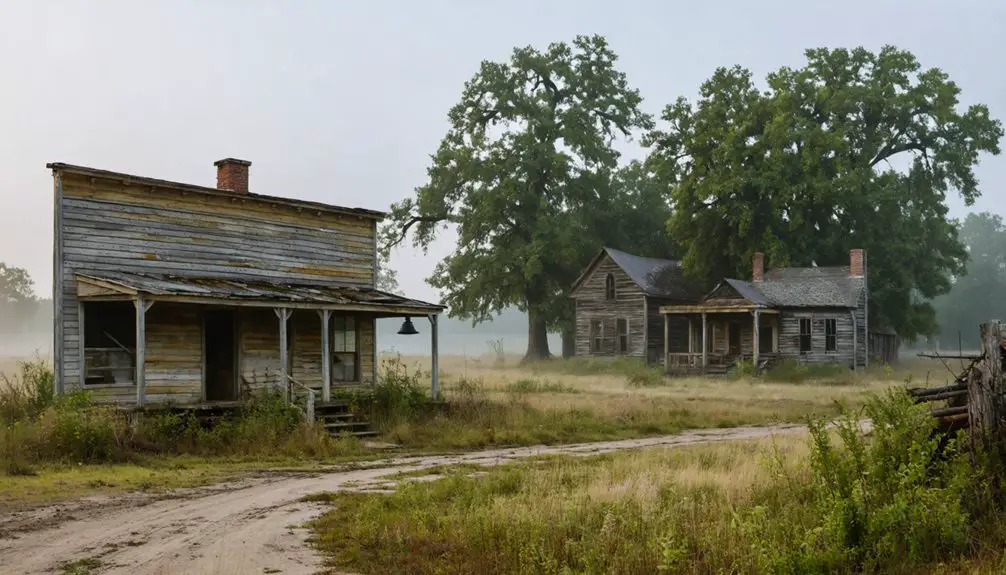
The relocation of the Choctaw Nation’s capital to Chahta Tamaha in 1863 marked a pivotal shift in tribal governance and regional power dynamics. You’d have witnessed the transformation of this small settlement, centered around Armstrong Academy, into a bustling hub of political activity and cultural identity.
The academy’s halls echoed with the voices of tribal leaders forging political alliances and shaping the nation’s future. During its two-decade tenure as capital, Chahta Tamaha flourished as the heart of Choctaw governance. The impressive two-story brick structure served as a symbol of the Nation’s progress and permanence.
You’d have found the town alive with commerce, as traders and settlers converged around the governmental center. The presence of Armstrong Academy fostered both educational advancement and administrative function, while council meetings at the institution steered the Choctaw Nation through the complexities of Civil War allegiances and post-war challenges.
The Decline and Abandonment of a Historic Town
Following the capital’s relocation to Tuskahoma in 1883, Chahta Tamaha experienced a swift and irreversible decline. The economic consequences were immediate, as government functions, businesses, and families departed the once-thriving town.
You’d have witnessed profound cultural shifts as the community’s social fabric unraveled.
The destruction of Armstrong Academy by fire in 1921 delivered the final blow to the town’s survival. This catastrophic loss, coupled with the federal government’s refusal to rebuild, eliminated the last major institution binding the community together.
The railroad’s decision to bypass Chahta Tamaha two miles to the south further isolated the settlement.
Today, you’ll find only foundation remnants and a cemetery marking this historic site, which stands as a reflection of how quickly a thriving capital can transform into abandoned pastureland.
Legacy and Present-Day Historical Significance
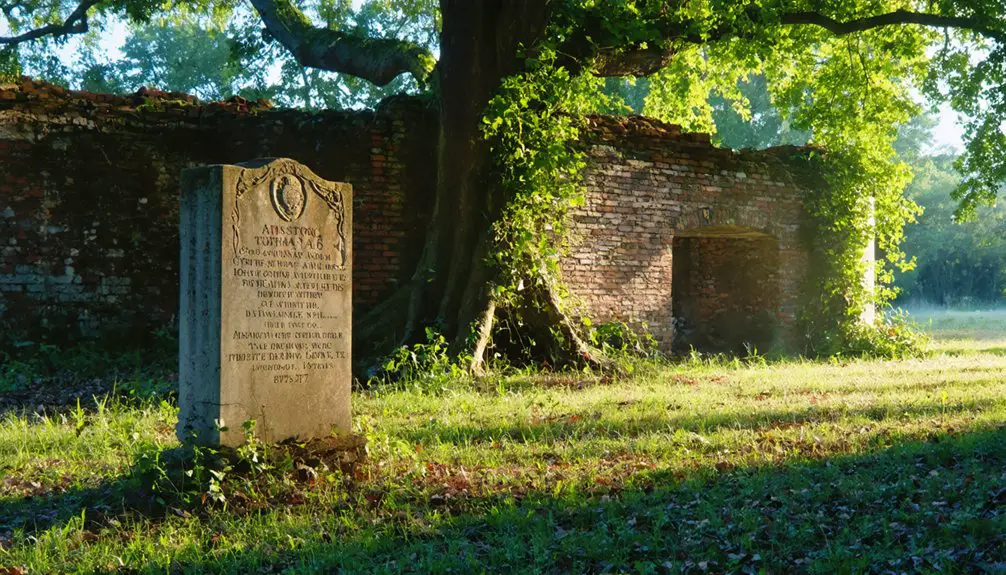
Despite its physical abandonment, Chahta Tamaha’s legacy endures through its pivotal role as the Choctaw Nation’s capital from 1863 to 1883 and its designation on the National Register of Historic Places.
You’ll find its cultural identity preserved through the Armstrong Academy Cemetery, which serves as a tangible link to the town’s educational heritage and historical preservation efforts.
Though no structures remain standing, the site’s significance lives on as a tribute to Native American governance and resistance during the Civil War era.
Today, the former capital’s spirit continues at Tvshka Homma, where the relocated Capitol Building hosts cultural demonstrations and ceremonies, ensuring that Chahta Tamaha’s role in shaping Choctaw political identity isn’t forgotten in the pages of history.
Frequently Asked Questions
What Traditional Ceremonies Were Performed at Chahta Tamaha During Its Peak Years?
Despite 1930s missionary suppression, you’d have witnessed vibrant traditional rituals including Choctaw social dances, marriage ceremonies, and spiritual gatherings that blended ancestral practices with Christian elements, reinforcing cultural significance through communal celebration.
How Many Students Attended Armstrong Academy Before It Became the Capital?
You’ll find that student enrollment at Armstrong Academy grew from 33 students in 1846 to between 65-100 pupils by 1859, marking its historical significance before becoming the Choctaw Nation’s capital.
What Was Daily Life Like for Residents of Chahta Tamaha?
You’d spend your days farming, hunting, and trading at the local post. Community gatherings centered around church services, while political meetings and council activities shaped your routines if you lived during the capital years.
Were There Any Notable Archaeological Discoveries Made at the Site?
You’ll find archaeological findings included Native American pottery mimicking European designs, mixed European-American trade goods, and two significant burial sites at the Opel location within the first eight inches of soil.
What Specific Trade Goods and Commerce Flowed Through Chahta Tamaha?
Like rivers of prosperity, you’d find cotton, cattle, and general supplies flowing through essential trade routes. The riverboat commerce brought provisions, tools, and blacksmith services until 1912’s commerce impact.
References
- https://en.wikipedia.org/wiki/Chahta_Tamaha
- https://mike-boucher.com/wordpress/?page_id=244
- https://www.choctawnation.com/news/iti-fabvssa/tvshka-homma-capitol-of-the-choctaw-nation/
- https://en.wikipedia.org/wiki/List_of_ghost_towns_in_Oklahoma
- https://www.okhistory.org/publications/enc/entry?entry=TA010
- https://kids.kiddle.co/Chahta_Tamaha
- https://gateway.okhistory.org/ark:/67531/metadc2016981/m2/1/high_res_d/2011-v89-n03_COO_Miles.pdf
- http://blogoklahoma.us/place/67/bryan/chahta-tamaha
- https://www.choctawnation.com/news/iti-fabvssa/architectural-history-of-the-choctaw-nation-capitol-buildings-1834-1883/
- https://bcgla.org/2022/12/12/armstrong-academy/
